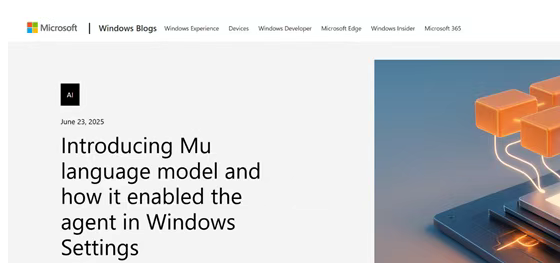Microsoft Unveils Mu: A Compact AI Model for Windows
Microsoft Releases Mu: A Breakthrough in Small-Parameter AI
Microsoft has officially introduced Mu, its latest small-parameter AI model, boasting just 330 million parameters yet delivering performance comparable to the larger Phi-3.5-mini. This innovation is tailored for local deployment on NPU-equipped devices, achieving speeds of over 100 tokens per second—a rare feat for compact models.
Empowering Windows with Natural Language Agents
A standout feature of Mu is its ability to power AI agents within Windows. Users can issue natural language commands—like "Make the mouse pointer larger and adjust screen brightness"—and Mu translates these into system actions seamlessly. This functionality enhances usability by eliminating manual navigation through settings menus.

Architectural Innovations Behind Mu
Mu’s design draws from Microsoft’s Phi Silica model but is optimized for efficiency. Key advancements include:
- Dual Layer Normalization: Improves training stability by normalizing activations before and after each sub-layer.
- Rotary Position Embedding (RoPE): Enhances long-sequence handling by dynamically encoding token positions.
- Grouped-Query Attention: Reduces memory usage while maintaining performance by sharing keys and values across attention heads.
Trained on A100 GPUs, Mu leverages knowledge distillation from Phi models to achieve high accuracy despite its small size. Microsoft also employed techniques like warm-up decay schedules and the proprietary Muon optimizer to refine performance.
Perfecting Windows Agents: Low Latency Meets Precision
Microsoft’s goal was to create an AI agent capable of understanding natural language and executing system changes with minimal delay. After testing multiple models, Mu emerged as the ideal candidate due to its balance of speed and accuracy. Fine-tuning involved:
- Scaling training data to 3.6 million samples (a 1,300x increase).
- Expanding supported settings from 50 to hundreds.
- Using synthetic data generation and noise injection to improve robustness.
The result? A Windows agent that responds in under 500 milliseconds, making it practical for real-world use.

Key Points
- Compact Powerhouse: Mu matches Phi-3.5-mini’s performance with 10x fewer parameters.
- NPU-Optimized: Delivers 100+ tokens/second on offline devices.
- Windows Integration: Enables natural language control over system settings.
- Innovative Architecture: Features RoPE and grouped-query attention for efficiency.
- Real-World Ready: Fine-tuned for low-latency, high-accuracy responses.